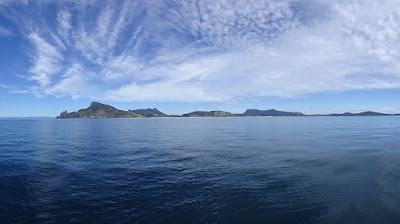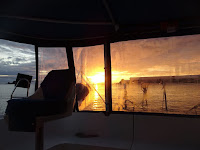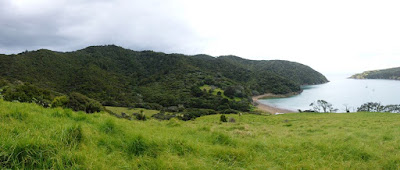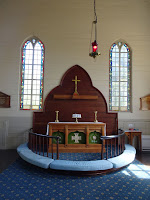[Kyle]From Whangaruru, we sailed down the coast to the epicenter of North Island sport fishing, Tutukakaka. We had plenty of wind and depending on whether it was being blocked by a hill or funneled by a valley, we alternated between a nice sedate sail (crawl) and a fast romp, kicking up rooster tails in our wake.




Views from the sail between Whangaruru and Tutakaka
There were very few boats, but plenty of wild fish activity with large patches of ocean suddenly splashing with activity.
When we finally got there, the narrow entrance was hidden behind the giant boulder of Tutukaka Head. We knew it was there, though, because every now and then a fishing boat would suddenly appear from out of the cliffs as if by magic.
We made our entrance by passing a few boat widths from the cliffs, heading directly at some nasty looking rocks and then making a ninety-degree turn through the narrow entrance just before we hit them. Inside, perfectly protected from the conditions outside, were several placid little coves dotted with boats swinging on their moorings or at their anchors. We placed ours between the edge of the moored boats and the channel to the marina. What a beautiful spot! We were surrounded by tree covered rocks and beaches of red and yellow sand.
We were just getting ready to go out and explore when the skies opened up and drove us back into our dry cabin. Never mind that plan. Maybe it’s an indoor kind of day.
Ten minutes later, bright sunlight cast crisp shadows through the cabin windows and it started to rain even harder, making everything seem very sparkly. What the hell‽ Ten minutes after that, the rain stopped and the sky turned a brilliant blue. We decided to launch the dinghy before it began to snow.
It never did. We had a nice leisurely row to the dinghy dock at the marina, making a point of tracing our way along the convoluted coastline. Once we were ashore, we poked around a little until we found the path to the light on Tutukaka Head. It started as a stroll down a quiet street through some very lovely homes, all with amazing views along the coast. Then it turned into an easy walk across the grassy pastures at the ridgeline. Along the way, there were plenty of benches on which to pause for a moment and enjoy each particular vantage point.
After a while, the meadow ended and the trail turned into an unbroken set of hundreds of stairs that plunged down to the beach below. There, at low water, a thin strip of land crosses over to Tutukaka Head, passing several tiny coves on both the ocean and the harbor sides.
At the far side of the beach, the trail starts up steeply again and wraps its way around the little island as it climbs. There are regular gaps in the trees, which always caused us to stop in our tracks and gasp at the beauty before us. This place is REALLY nice!
Finally, the trail made one last steep ascent before emerging at the navigation light on top of the hill to 360 degree views of the whole coast. Wow! The coast to the north is beautiful. The coast to the south is beautiful. The harbor with all of its picture perfect coves is beautiful. Even the ocean, which should look like any old ocean, was beautiful because there were a bunch of sublimely rocky islands in the middle distance. What a place! We were so glad the rain had stopped.




Sunny skies for a beautiful trail
We retraced our route back, amazed at how pretty all of the same stuff was from the new angles and with a different light. We weren’t feeling ready to call it a day just yet, so we popped into the Fishing Club for a beer and a game of pool. The Fishing Club serves as the Yacht Club, since most of the boats in the area are sport fishing boats. The walls were adorned with GIANT mounted trophies and pictures of proud fishermen being dwarfed by their catches as they hang from the crane along the wharf. There were more examples than we could count of fish that were twice as long or twice as heavy as their captors. One surprisingly skinny little guy caught a 325kg (715lb) Marlin that was 5.3m (18’) long!
We just made it back to Begonia before the rain returned, creating the perfect cozy atmosphere for a traditional warm Thanksgiving dinner.




